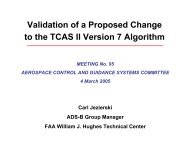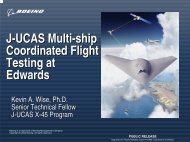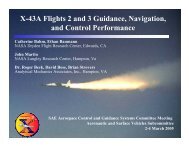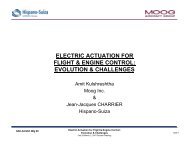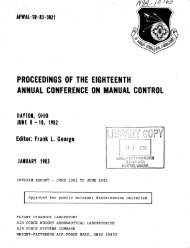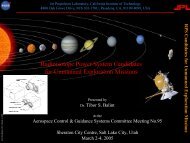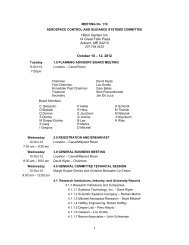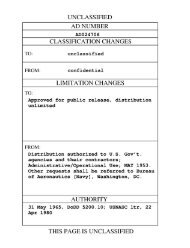Report of the Second Piloted Aircraft Flight Control System - Acgsc.org
Report of the Second Piloted Aircraft Flight Control System - Acgsc.org
Report of the Second Piloted Aircraft Flight Control System - Acgsc.org
You also want an ePaper? Increase the reach of your titles
YUMPU automatically turns print PDFs into web optimized ePapers that Google loves.
Equations (21) and (22) are written in terms <strong>of</strong> transient response parameters<br />
but apply to frequency redponse parameters by replacing S and E<br />
with St and El, respectively. The corresponding equations for <strong>the</strong><br />
varioue sizes <strong>of</strong> a rotary servomotor in terms <strong>of</strong> <strong>the</strong> various design<br />
parameters may be obtained from equations (9) and (10) in a similar<br />
menner .<br />
Equation (21) expresses <strong>the</strong> relation between <strong>the</strong> motor inertia ( roportional<br />
to 9)<br />
I<br />
and <strong>the</strong> various response parameters. Equation (22<br />
expresses <strong>the</strong> relation between <strong>the</strong> input inertia (proportional to RW<br />
and <strong>the</strong> various response parameters. The motor inertia and <strong>the</strong> input<br />
inertia are signif icant factors in <strong>the</strong> design <strong>of</strong> high speed servomotors .<br />
The following paragraphs will diecues methods for aiding in <strong>the</strong> selection<br />
<strong>of</strong> optimum designs to meet specifications on ei<strong>the</strong>r <strong>the</strong> transient or<br />
frequency response characteristics.<br />
Determination <strong>of</strong> Design Parameters<br />
Load mass. - The value <strong>of</strong> M in <strong>the</strong> design equations includes <strong>the</strong><br />
mass <strong>of</strong> <strong>the</strong> output part <strong>of</strong> <strong>the</strong> servomotor as well as <strong>the</strong> load mass. In<br />
high-speed applications <strong>the</strong> motor mass may be a significant percentage<br />
<strong>of</strong> <strong>the</strong> total mass. For this reason <strong>the</strong> estimated mass <strong>of</strong> <strong>the</strong> output part<br />
<strong>of</strong> <strong>the</strong> motor should be added to <strong>the</strong> known load mass. It is obvious from<br />
<strong>the</strong> character <strong>of</strong> <strong>the</strong> response <strong>of</strong> hydraulic servomotors <strong>of</strong> this type that<br />
<strong>the</strong>, responee~,characteristics for a given size are always improved by<br />
reductions in <strong>the</strong> load mass.<br />
Pressure differential across servomotor. - In general <strong>the</strong> size <strong>of</strong> a<br />
servomotor for a given response is reduced by an increase in pressure differential.<br />
The reduction in weight, however, is modified by <strong>the</strong> need for<br />
larger sections to withstand <strong>the</strong> increased pressure. The determination<br />
<strong>of</strong> <strong>the</strong> optimum pressure' is beyond <strong>the</strong> scope <strong>of</strong> this paper. The no-load<br />
time constant varies' inversely as <strong>the</strong> square root <strong>of</strong> <strong>the</strong> pressure differential'whereaa<br />
<strong>the</strong> inertia index is independent <strong>of</strong> <strong>the</strong> pressure diff<br />
erential. Therefore in a given servomotor <strong>the</strong> break frequencies. (f<br />
and f3) are proportional to <strong>the</strong> sqwe root <strong>of</strong> <strong>the</strong> pressure differential,<br />
and <strong>the</strong> rise time is approximately inversely proportional to <strong>the</strong> square<br />
root <strong>of</strong> <strong>the</strong> pressure differential.



